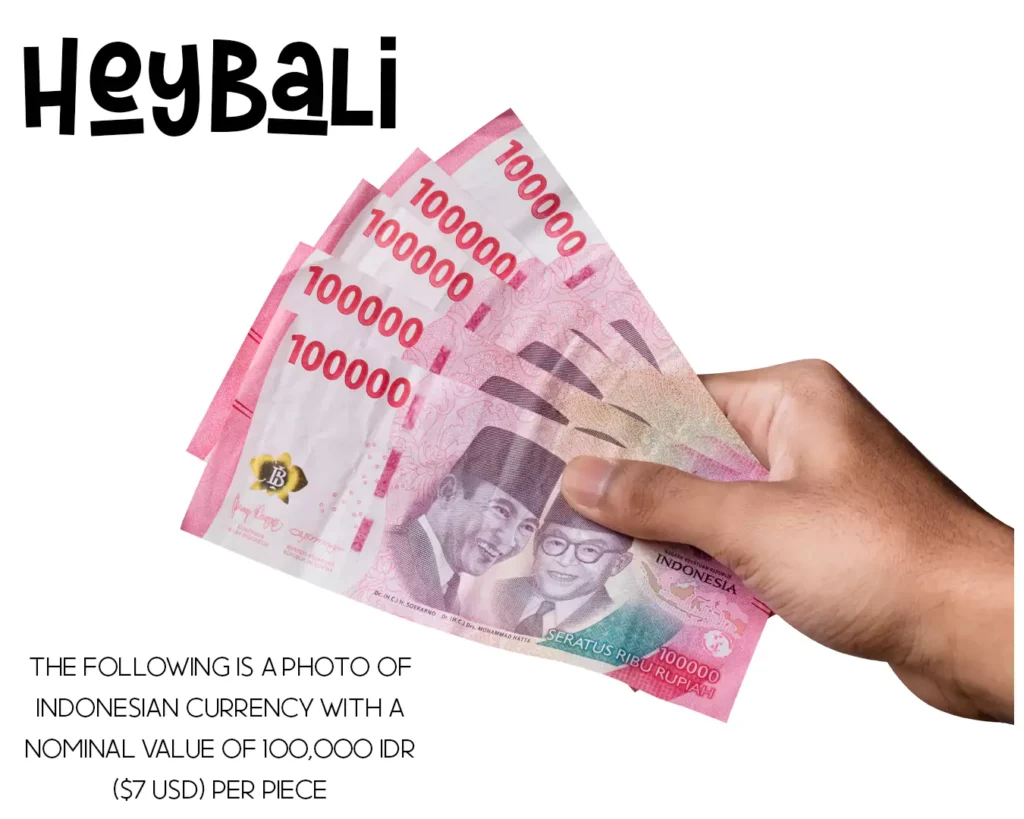Chapters
ToggleBali Currency & Bali Money – Planning a trip to Bali? While the island’s stunning beaches and vibrant culture are the main attractions, understanding Bali’s currency system is just as important – it can save you from unnecessary stress and costly mistakes.
Definition: Bali's currency is the Indonesian Rupiah (IDR), the official currency of Indonesia. It is used for all transactions on the island, with banknotes ranging from 1,000 to 100,000 IDR and coins being less common.
Key Takeaways
- Understanding the Indonesian Rupiah (IDR) is crucial for managing expenses in Bali.
- Exchange rates can vary, so it’s important to check current rates before converting money.
- Avoid exchanging money at the airport, as rates are often less favorable.
- Hidden fees may apply when withdrawing money from ATMs or using certain payment methods.
- Always carry a mix of cash and digital payment options for convenience and flexibility.
- Being aware of common scams and overcharging can help you save money and enjoy your trip stress-free.
Many travelers, especially those visiting for the first time, often find themselves overwhelmed by confusing exchange rates, hidden fees, and unfamiliar banknotes. 😕 Don’t let money matters spoil your paradise experience! Whether you’re a first-timer or a seasoned traveler, navigating Bali’s financial landscape can be tricky. But don’t worry – Hey Bali has got your back!

Let me tell you a story – Bali Currency Exchange:
Sarah, a first-time traveler from Canada, landed in Bali excited to explore. After exchanging her money at the airport, she wandered into an Ubud market and found a beautiful Balinese woven handbag priced at 275,500 IDR. Confused by the currency conversion, she struggled to calculate how much that was in Canadian dollars and worried about overpaying. Uncertain and flustered, Sarah walked away, missing out on the item she wanted. This is a common scenario we want to help you avoid. At Hey Bali, we’ll guide you through Bali’s currency system so you can confidently manage your money and enjoy your adventure without stress.
In this guide, Hey Bali will walk you through mastering Bali’s currency, the Indonesian Rupiah, and share tips to help you avoid those common financial pitfalls that could hurt your travel budget.
From understanding the basics of the Rupiah to smart money management strategies, we’ll equip you with everything you need to ensure your Bali adventure is both unforgettable and financially savvy (financial confidence in Bali). 💡💰
Understanding Bali Currency Landscape

Hey Bali here! If you’re planning a trip to Bali, one of the first things you’ll want to get a handle on is the local currency scene. Trust me, knowing a bit about how the money works will help you breeze through transactions and avoid any wallet woes. So, let’s break down the essentials of Bali’s currency system so you’re all set for your adventure.
Bali’s Official Currency (Bali Money)
The Indonesian Rupiah (IDR) is what you’ll be using for everything from that delicious street food to souvenirs at the local markets. It’s the official currency of Bali and all of Indonesia, so it’s worth getting familiar with it. Here’s the scoop:
- Denominations: The rupiah comes in both coins and banknotes.
- Coins: 100, 200, 500, and 1,000 rupiah (not super common but can come in handy).
- Banknotes: 1,000, 2,000, 5,000, 10,000, 20,000, 50,000, and 100,000 rupiah.
- Appearance: IDR banknotes are colorful and usually feature famous Indonesian figures, cultural icons, or landmarks. You’ll spot them easily because they’re vibrant and eye-catching.
- Symbol: The symbol for the rupiah is “Rp.” So when you see Rp 100,000, that’s what you need to keep an eye out for when making purchases.
A Quick Heads-Up: The rupiah can seem a bit intimidating at first because of all those zeros. For example, a 100,000 IDR note is roughly equal to 7 USD (as of 2024). It’s easy to get mixed up, so double-checking is always a good idea.
| Rupiah (IDR) | Approximate USD Equivalent |
| 10,000 | $0.70 |
| 50,000 | $3.50 |
| 100,000 | $7.00 |
| 500,000 | $35.00 |
| 1,000,000 | $70.00 |
So, whether you’re eyeing a street-side snack or splurging on a spa day, having a basic understanding of Bali’s currency will make your trip more enjoyable and stress-free.
“Learning from the “Sarah” case example above, it can be concluded that the price of a Balinese woven bag seen at the Ubud Art Market at 275,500 IDR is equal to $18.4 USD. The price given by the seller is standard and reasonable.”

Bali Exchange Rates and Their Fluctuations
When you’re traveling to Bali, understanding exchange rates is key to making the most of your money. The difference between your home currency and the Indonesian rupiah (IDR) can really affect what you can buy, so it’s good to stay informed. Here’s what you need to know:
Source: https://currencyrate.today/exchangerates-widget- Volatility: Exchange rates can change daily, influenced by various economic factors. So, what you see today might not be the same tomorrow.
- Stay Updated: Keep an eye on current rates using trusted currency conversion apps or websites. This will help you get a better idea of the rate you’re getting.
- Bank Rates vs. Money Changers: Banks sometimes offer slightly lower rates compared to authorized money changers, so it’s worth shopping around.
- Airport Exchanges: If you can, avoid exchanging money at the airport – the rates are often not great compared to those in town.
- Calculate Ahead: Before making a purchase, quickly convert the price into your home currency so you know what you’re paying and don’t get surprised later.
Pro Tips for Getting the Best Value:
- Exchange just enough at the airport for immediate needs (like a taxi ride or small snack), and look for better rates in town.
- Carry a mix of cash and cards to avoid having too much cash on you.
- Always double-check your money after exchanging it to make sure everything’s in order and that there are no counterfeit notes.
Common Currencies Accepted in Tourist Areas

While the Indonesian rupiah is the official currency, some tourist areas in Bali accept other major currencies. However, it’s generally advisable to use rupiah for most transactions. Here’s a breakdown of commonly accepted currencies in tourist zones:
- US Dollar (USD): Widely accepted in many tourist establishments.
- Euro (EUR): Accepted in some high-end hotels and restaurants.
- Australian Dollar (AUD): Occasionally accepted due to the high number of Australian tourists.
- Singapore Dollar (SGD): Sometimes accepted in larger establishments.
It’s important to note that while these currencies might be accepted, you’ll likely get a poor exchange rate compared to using rupiah. Here are some pros and cons of using foreign currencies in Bali:
Pros:
- Convenience if you’re short on rupiah
- Useful for large purchases in some establishments
Cons:
- Less favorable exchange rates
- Not widely accepted outside tourist areas
- May receive change in rupiah, leading to a mix of currencies
To make the most of your Bali currency experience, consider these best practices:
- Always carry some rupiah for small purchases and local markets.
- Use credit cards in established businesses for larger transactions.
- Inform your bank about your travel plans to avoid card blocks.
- Be cautious of dynamic currency conversion (DCC) when using cards – always choose to pay in rupiah.
The first steps to a financially smooth trip to Bali is to understand the currency landscape of the island. By familiarizing yourself with the Indonesian rupiah, keeping track of the exchange rate, and knowing what currencies are accepted at tourist places, you’ll be all set to take care of money matters on your Bali vacation.
Now that we’ve covered the basics of Bali’s currency landscape, let’s take a closer look at the Indonesian rupiah itself and how to navigate its unique characteristics.
Next Page : Getting to Know the Indonesian Rupiah










































































